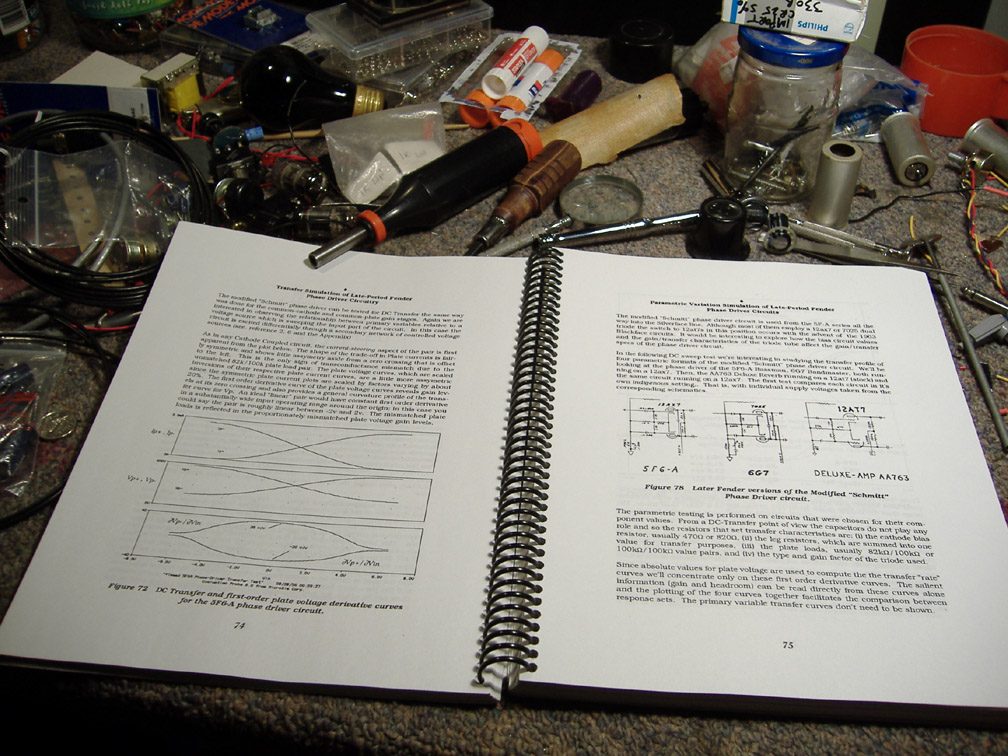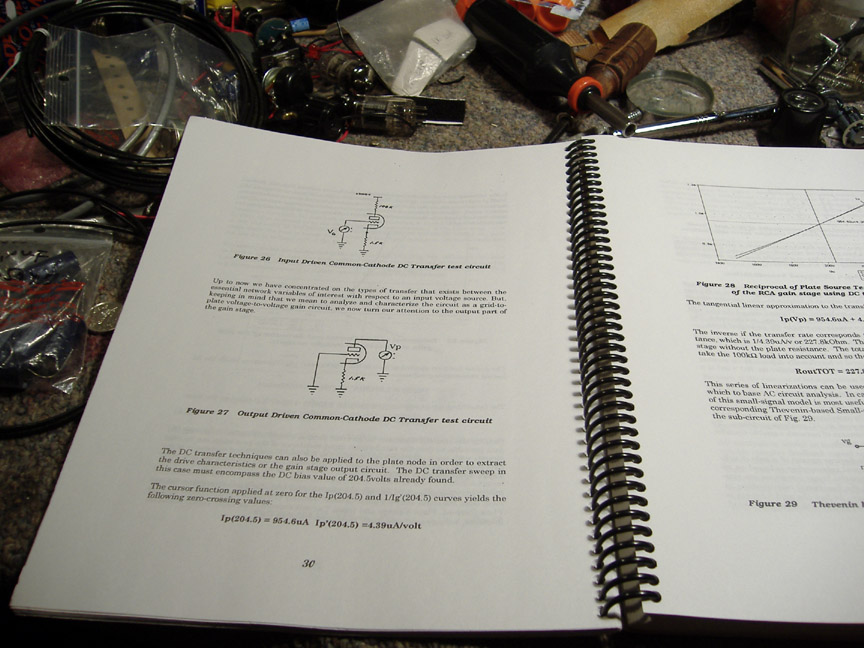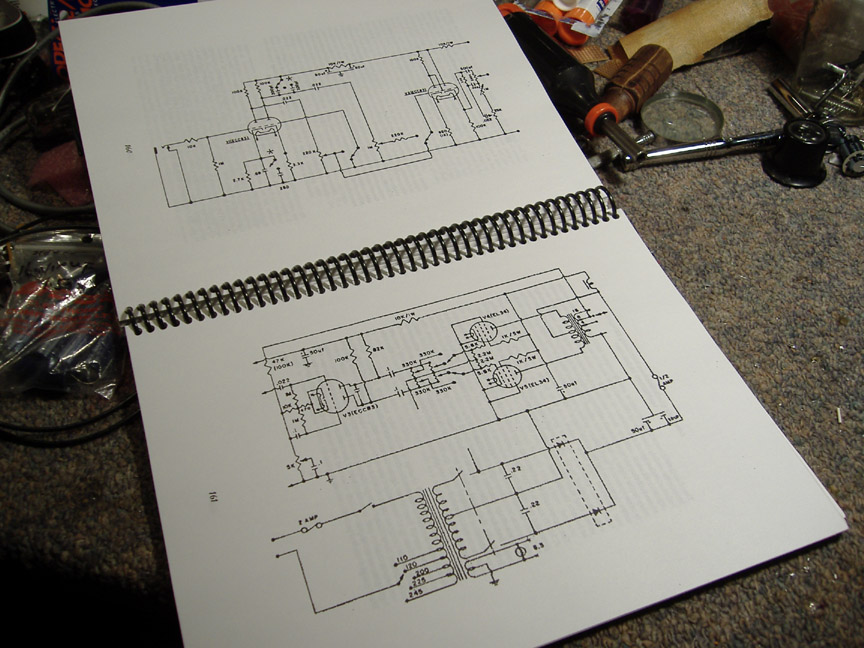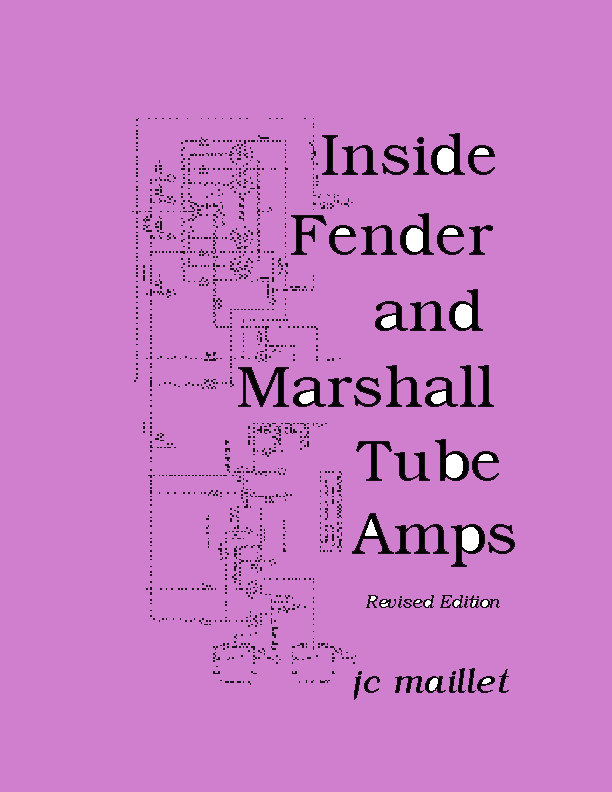"Inside Fender and Marshall Tube Amps"
by JC Maillet
ISBN 0-9684849-0-5
 |
Modern Analysis of Vacuum Tube Amplifier Circuitry
- TABLE OF CONTENTS -
2001 Revised Edition
Table of Contents
Mathematical Modeling of Vacuum Tube Triode Devices 1
Qualitative Description of Electronic Transconductance Devices 2
Quantitative Description of Electronic Transconductance Devices 4
Classic Exponential Description of Vacuum Tube Triodes 5
Small-Signal Description of Triodes 7
Small-Signal Interpretation of Classic Plate Equation 11
Application of Computer Techniques to Triode Gain Stages 13
Pspice Transient Analysis Output 15
Pspice DC-Transfer Analysis Output 16
Pspice AC Analysis Output 17
Pspice Analysis of Common-Cathode Triode Gain Stages 18
Gain Stage Transfer, Distortion and Definition of Signal Gain 22
Small-Signal Analysis of the Common-Cathode Gain Stage 31
AC Analysis of the Cathode Bypassed Common-Cathode Gain Stages 39
Pspice Analysis of Common-Plate Triode Gain Stages 41
Small-Signal Analysis of the Common-Plate Follower Stage 45
Parametric Modeling of Triode Gain Stages 49
Common-Cathode DC Transfer Characteristics 52
Parametric Variations of the 12ax7 Common-Cathode Transfer Specs 54
Variational Common-Cathode Test Conclusions 61
Common-Plate DC Transfer Characteristics -
Parametric Variations of the 12ax7 Common-Plate Transfer Specs 62
Differential Triode Circuits 65
Differential-to-Single-Ended Circuit Conversion 67
Phase Driver Circuits 69
Transfer Simulation of Late-Period Fender Phase Driver Circuitry 72
Parametric Variation Simulation of Late-Period Fender Phase Drivers 73
Hi-and-Lo Supply Voltage Simulation of Four Phase Driver Circuits 75
General Structure of Vacuum Tube Amplifiers 79
Variations Amongst Circuit Blocks 80
The Fender Power Supply 81
Audio Circuits as power Supply Loads 83
The RC-Ladder Filter Network - defining the TSR Index 84
Rectifier Turn-On Characteristics 87
The CBS power Supply: Fender design Alterations 88
Fender Push-Pull Output Stages 89
Fender Vibrato Circuits 93
Bias-Modulating Vibrato Circuits 94
Photocell Based Vibrato Circuits 98
Phase-Cancellation Vibrato Circuits -
Bandwidth Control 100
Signal Coupling and Cathode Bypass Caps -
Tone Stack Component Values 104
Transient Fidelity in Guitar Tube Amps 106
The Non-linear Dynamics of Triode Gain Stages 107
Variable Compression from Non-linear Systems with Memory 108
The Role of Grid-Blocking Resistance 110
Interstage Resistance: tweed and Blackface Designs 111
Shadowing: Dielectric Adsorption in Signal Caps 114
Class-AB Biasing 116
Making The Notch Go Away 117
Maintaining Power Tube Matching Over Time 120
Recommended Tranny-Shunting Safety Precautions 121
Fine-Tuned Bias by Ear -
Neutral Fender Mods 122
Single-Ended Tweed Filament Hum Cancellation -
Silverface Filament and Bias Circuits 124
Late 60s and Later Silverface Bias Circuits 125
Improved Fender Bias Circuit 126
Alternative Bias Circuit Sourcing -
Lead Dress for Improved Hum Cancellation -
Examples of Modded Fender Silverface Amplifiers 128
Silverface Power Supply Variations 129
Silverface Signal Path Variations 130
Balance of Overall Overdrive Characteristics 131
Balance of Overall Amplifier Power and Gain 132
MOD (A) Hot 6L6 Pentode Performance -
Hot Blackface-style 6L6 Output Stage 135
MOD (B) Extreme Single-Channel Blackface Performance 137
MOD (C) Tweed Signal Path with Direct Coupled Reverb Recovery 139
MOD (D) British Super Tweed Reverb 142
MOD (E) Deluxe Reverb: The Stranglehold Variation 143
Low-End Deluxe bandwidth Extension -
Deluxe Power Supply Revamp 145
MOD (F) Sampo Kolkki Reverb Re-route 161
Master Volume Control in Fender Amp Mods 147
Marshall Circuit Overview 150
Bridgeable Volume Controls 151
The Master Volume Control -
Marshall Power Supply and Filter Distribution Network 152
Marshall Amp Mods 153
Hot-Rodding / Restoring the JCM800 Master Volume Preamp 154
Dual-Mode Marshall Switching Circuit 155
Adapting the 2-channel Switching Circuit to JCM800s 157
Adapting the 2-channel Switching Circuit to JCM900s 160
MOD (G) to Model 2550 JCM900s 161
MOD (G) to Model 4100 JCM900s 163
 |
Annex
The Small-Signal Algebra of Triode Gain Stages 166
AC-Circuit Algebra of the Common-Cathode Gain Stage - AC-Circuit Algebra of the Common-Plate Gain Stage 170
Vacuum Tube Modeling for Pspice Simulation 174
Basic network properties -
One Last Look at the Power Function 185
Fender Schematic Chronology 187
Fender Amplifier Bias Data by Model Name 188
Fender Amplifiers - Partial Listings 191
Tweed A, B, C, D, D, F, ... -
Brownface 5G, 6G, ... 205
Blackface aa763, AB763, ... 212
Silverface •68, •69, 70, ... 220
My Lonely Triode Pspice Models 223
The Triode pspice Models of Reynolds and Koren 224
Phase Driver Pspice Simulation Files 225
The Naked Champ 227
Crude Power Supply Simulation -
Some Ideas from Ken Fischer on
Plexi-ing Metalface Marshall Amps 230
Observations and Recommendations -
Cleaning Up the Metal-face model 1959 SL100 231
Adjusting or Disabling the Marshall Feedback Loop 232
Tubes and Transistors 233
Transistor DC Terminal Characteristics -
Tube Amps and Effects 235
Playing with Effects Live -
About Digital Signal Processing (DSP) Circuits -
Controlling Distortion by curbing Low End response 238
Canadian Made Garnet and Traynor Amps 239
Miscellaneous Layout 243
 |
** Inside Fender and Marshall Tube Amps **
ISBN 0-9684849-0-5
** CURRENTLY AVAILABLE **
PDF of this book can be ordered here:
 |
